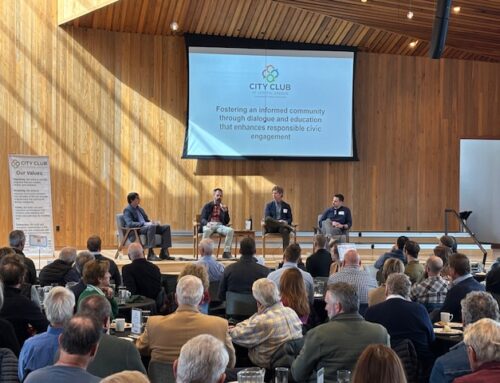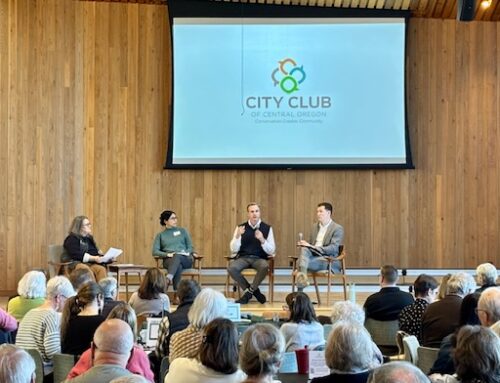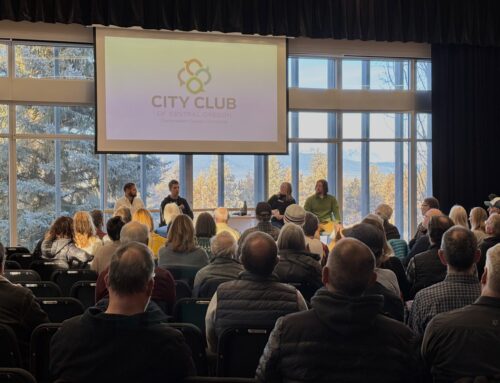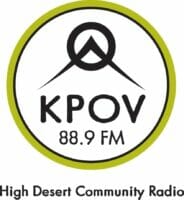August 18, 2022
Water defines the landscape in Central Oregon-from Wickiup Reservoir to irrigation in Jefferson County-and all the uses in between. This forum will explore the conservation, technology and policy solutions to how we can do more with less water.
Moderator: Zack Demars, Special Projects Reporter for The Bulletin
Panelists:
Erin Kilcullen, General Manager – Deschutes Soil and Water Conservation District
Kate Fitzpatrick, Executive Director – Deschutes River Conservancy
Michael Buettner, Utility Director – City of Bend
Kevin Richards – Fox Hollow Ranch
Q&A
We were not able to get to all the audience questions, here are some answers to the remaining questions.
- Are water rights something you would see on a property deed?
- Erin Kilcullen: An Oregon water right is sold with the property. In Oregon, water rights are appurtenant to the land upon which the water is applied. Water rights transfer automatically with the transfer of land, unless expressly reserved by the sellers.
- Kate Fitzpatrick: It is possible that there may be a mention of water rights on a deed. However, the official water right of record is kept in the Salem Oregon Water Resources Department. Deed records should not be relied upon as an official statement of water rights. There are some irrigation district easements that may be on a deed and those should be addressed with the specific irrigation District noted.
- Irrigators, agricultural users, and cities all contribute financially to the efforts to restore streamflows, conserve water, etc. Exempt well users don’t. How do we address this?
- Kate Fitzpatrick: Groundwater uses exempt from needing a water right include generally include domestic use not exceeding 15,000 gallons/day and lawn or noncommercial garden watering of not more than one-half acre. More information on exempt wells can be found here: https://www.oregon.gov/owrd/WRDReports/ExemptUseHandout.pdfExempt well users do not pay for their water (besides their private pumping costs) and are not required to measure or report on their water use, although they are required to use the water ‘beneficially without waste.’
There could be voluntary programs for exempt well users to ‘offset’ their impacts by contributing to a fund that restores streamflows. For example, Avion has a checkbox ‘Blue Water’ program where patrons within the Avion system can contribute to the Deschutes River Conservancy’s instream leasing program through their monthly bills. Theoretically, a program like this could be expanded to exempt well users. Mandatory programs would require legislation at the state level to ‘pay’ for the right to use exempt wells and would need to direct this revenue towards flow restoration.
- Kate Fitzpatrick: Groundwater uses exempt from needing a water right include generally include domestic use not exceeding 15,000 gallons/day and lawn or noncommercial garden watering of not more than one-half acre. More information on exempt wells can be found here: https://www.oregon.gov/owrd/WRDReports/ExemptUseHandout.pdfExempt well users do not pay for their water (besides their private pumping costs) and are not required to measure or report on their water use, although they are required to use the water ‘beneficially without waste.’
- I would love to tear out some of my lawn, but xeriscaping projects can be expensive. Does the city have any incentives to help homeowners with xeriscaping projects?
- Erin Kilcullen: Yes, if you have City of Bend Water for your home, the City of Bend offers rebate programs for irrigation improvement projects. Information can be found at: https://www.bendoregon.gov/government/departments/rebates. The City of Bend also has great resources for water wise landscaping at: https://www.bendoregon.gov/government/departments/utilities/conservation/waterwise-landscaping.
- Mike Buettner: The City of Bend provides a handful of guides, workshops, and informational resources at their conservation site www.waterwisetips.org that help guide landscape owners through the transition process. Conservation staff currently provide four different incentives as a part of the Sprinkler Inspection Program. This is a pilot that will lead to and expanded suite of incentives and rebates available in 2023.
- Can we define “beneficial use” within our districts, to help identify the more productive water users within the district?
- Erin Kilcullen: If your property has a surface water right with an irrigation District that you pay for annually, beneficial use is defined as the following: Per Oregon Revised Statute and Oregon Administrative Rule, a water right holder is required to beneficially use a water right for its intended purpose without waste, once every five consecutive years. An irrigation water right is considered beneficially used when something is planted (such as a crop, pasture, yard, or other landscaping), irrigated, and producing. Irrigation of native vegetation such as sagebrush and bunchgrass, or invasive and non-invasive weeds (cheatgrass, foxtail, etc.) is not beneficial use of an irrigation right. If a landowner is properly using their water right for beneficial use according to the irrigation District, it does not matter the productivity of the land according to OR Water Law. This could be discussed in more detail with your Irrigation District.
- Kate Fitzpatrick: ‘Beneficial uses’ are not currently prioritized in the state water rights system. There are examples of districts or regions beginning to prioritize based on productive/economic water use in other areas of the West, particularly in areas of extreme scarcity.
- Kyle Gorman: This would be a challenging endeavor and would create classes of water users within an irrigation district. These classifications would likely lead to lawsuits.
- How strong is our water aquifer?
- Kate Fitzpatrick: The groundwater flow system (or regional aquifer) is relatively thick. Several groundwater studies have estimated the thickness of the aquifer. Thickness can vary depending on where you are in the basin, but the regional aquifer underlying much of the Upper Deschutes Basin averages 1,000 feet thick. A 2017 report identified average annual groundwater recharge as 4,436 cubic feet per second, and identified 76 cubic feet per second of groundwater usage at that time. While our aquifer is relatively thick, the state is reporting declines which vary spatially across the basin, and which are larger the further one gets from the Cascade recharge zone. Groundwater declines are influenced primarily by precipitation but activities that reduce recharge or increase pumping from the aquifer can also impact the aquifer.
- The irrigation water delivery valve on my NE Bend small/hobby farm is not metered. Why is this? It seems hard to conserve what isn’t being measured.”
- Kate Fitzpatrick: Measurement varies across irrigation districts. Some districts measure using weirs. If you share a privately-owned lateral with other irrigation district patrons, the district may only measure water deliveries at the shared point of diversion. Increased measurement and control of water use throughout irrigation districts would be beneficial for overall water management.
- What effect does the Deschutes Basin Habitat Conservation Plan have on irrigation water delivery to North Unit Irrigation District in the long term?
- Kate Fitzpatrick: The irrigation districts are working together to meet winter instream flow targets in the Habitat Conservation Plan through conserving water in more senior irrigation districts, making that water available to North Unit Irrigation District, in exchange for restoring water stored in reservoirs instream in the winter. If the partnerships and projects proceed as planned, impacts to NUID from meeting HCP winter flow restoration goals should be mitigated. However, when the winter flows from Wickiup Reservoir reach 300 cfs, there will be impacts to the supply for North Unit Irrigation District unless the districts with senior rights have reduced their diversions by an equivalent amount.
- Kyle Gorman: However, when the winter flows from Wickiup Reservoir reach 300 cfs, there will be impacts to the supply for North Unit Irrigation District unless the districts with senior rights have reduced their diversions by an equivalent amount.
- Deschutes county declared a drought march this year, why has City of Bend not implemented water conservation Level 1 of its water management plan? Wouldn’t it behoove COB to save H2O today & not wait 20 years?
- Mike Buettner: The City of Bend’s Water Management and Conservation Plan includes a chapter on water curtailment that outlines the Seasonal Water Use Advisory and three stages of water curtailment. The City entered into the Seasonal Water Use Advisory early in 2022 based on dry conditions. Conditions improved shortly after this and prevented further escalation into a Level 1 Water Shortage Alert.Water curtailment, and the initiating conditions that guide a utility’s actions to effectively reduce water demands, do not align well with drought in my opinion. They are primarily designed to deal with immediate and isolated impacts to meeting water demand within a system. Water curtailment is effective in responding to an extended power failure, major failure of water infrastructure, or terrorist attack. Drought is a longer-term event and warrants a different approach that embraces conservation and a continual reduction in water use per person.
- The graphic you presented shows river recharge from springs only above (south) of Benham Falls. Please comment about the existence and significance of river recharge from springs and groundwater to the north.
- Kate and Kyle: Significant spring discharge happens in and around the convergence of the Metolius, Deschutes and Crooked Rivers near Lake Billy Chinook, on the order of several thousand cubic feet per second. The geology of the basin drives this phenomenon due to impervious older rocks being exposed at river level at Lake Billy Chinook where the groundwater discharges to the stream system in copious amounts. This hydrogeology drives many aspects of water management in the Deschutes, including the existence of a Deschutes Groundwater Mitigation Program that requires ‘offsets’ to groundwater pumping in the Upper Deschutes Basin to prevent injury to scenic waterway surface water flows in the lower Deschutes River.
- In considering demand, has the legalization of cannabis, along with illegal growths had a measurable impact on our water dilemma and diverting from traditional farming?
- Kate Fitzpatrick: While hemp and cannabis operations have increased in the basin, they have not yet had the impact we are seeing in places like southern Oregon.
- Drive through Bend at midnight you will find incredible water waste: broken sprinklers, small flooding zones, heads directed into streets, on private & city properties.
- Encourage a culture of stewardship. Call the city if problems are noted. Call irrigation districts if water is being actively wasted. Increase the water awareness and visibility of these issues in the community.
- If Thornburgh’s owner was able to purchase water for his resort, is there a mechanism for a collaborative to purchase rights for farmers?
- Kate Fitzpatrick: Most of the water rights in the basin are managed by irrigation districts who have current policies disallowing water from being sold outside of the irrigation district. DRC and irrigation partners are working on establishing a water bank that would govern the voluntary reallocation of water from areas where it is less needed to areas of greater need. DRC’s next Raise the Deschutes Seminar Series Sept 12th will focus on the potential of water banks: https://www.deschutesriver.org/how-to-help/raise-the-deschutes-seminar-series/.
- Isn’t the issue that fish & fish habitats need? H2O year round not just in winter.
- Kate Fitzpatrick: Yes, the Oregon Department of Fish and Wildlife have established minimum flow goals in most of the basin’s reaches, many of which are for the summer months. DRC and partners have been working on making progress towards these goals.
- What percentage of the 700-plus miles of canals are piped? I have heard that about 10%.
- Kate Fitzpatrick: That is probably about right.
- What role do the tribes have in the central Oregon collaboration?
- Kate Fitzpatrick: The Confederated Tribes of Warm Springs(CTWS) helped to form the Deschutes River Conservancy in 1996 and continue to lead around a collaborative ‘good neighbor’ approach. The DRC board has two tribal seats including the current chair Bobby Brunoe (Secretary Treasurer/CEO of CTWS). Brunoe is also one of three chairs of the Deschutes Basin Water Collaborative. CTWS finalized its water rights settlement in the state of Oregon in the 1990s and is one of the few tribes of Oregon to have settled and adjudicated water rights. CTWS actively co-leads the reintroduction of salmon and steelhead above the Pelton Round Butte Dam Complex with Portland General Electric.
- How much water will the proposed Thornburgh resort use? And do panelists think a moratorium on projects that size/scope should be enacted?
- Kate Fitzpatrick: Impacts to surface and groundwater resources should be thoroughly assessed.
- Kyle Gorman: The original request was up to 6 million gallons per day but not that amount year-round. The developer recently came out with a reduction proposal to reduce the amount of water consumed by about 1/3. The development, if approved would have to mitigate for the consumptive use which, in theory, yields no additional use for the basin overall.
- Shouldn’t the COB be considering the stormwater it collects on a par with treated effluent reuse? Especially since greywater is more costly to treat…
- Mike Buettner: No. These are very different sources of water with very different challenges to using effectively and safely. But both are being pursued by the City of Bend.Stormwater is regulated through the Department of Environmental Quality through two separate regulatory permits. Much of what we do is regulated in this area, but the City will continue to capture and retain stormwater where possible. This reduces local flooding issues and improves water quality of stormwater destined for the groundwater table. The recent roundabout improvements along Newport Avenue in Bend are a good example of how we’re capturing stormwater, retaining it in basins, and focused on watershed protection. Future projects will be considered where appropriate and cost effective.
Treated effluent is different than greywater. The City’s Water Reclamation Facility can produce approximately 2-2.5 million gallons of treated effluent (treated wastewater) which can be used more effectively in the future. The City is scheduled to conduct a Facility Planning process within the next 12-18 months which will provide additional insight into the future of reuse from this facility.
- Mike Buettner: No. These are very different sources of water with very different challenges to using effectively and safely. But both are being pursued by the City of Bend.Stormwater is regulated through the Department of Environmental Quality through two separate regulatory permits. Much of what we do is regulated in this area, but the City will continue to capture and retain stormwater where possible. This reduces local flooding issues and improves water quality of stormwater destined for the groundwater table. The recent roundabout improvements along Newport Avenue in Bend are a good example of how we’re capturing stormwater, retaining it in basins, and focused on watershed protection. Future projects will be considered where appropriate and cost effective.
Resources
Slides from Forum
Community Conversations (9/1/22): Let’s Talk about Water
Raise the Deschutes Seminar Series
City of Bend Water Conservation Program
Deschutes Basin Water Collaborative
Deschutes Soil and Water Conservation District
Deschutes Basin water users scramble to make ends meet in century-old system
Arnold Irrigation District conservation projects close to approval, district manager says
Do we have enough water in Oregon? Depends who you ask
Race to the bottom: How Central Oregon groundwater sells to the highest bidders
Homeowners, developers and farmers compete for groundwater in Central Oregon


























